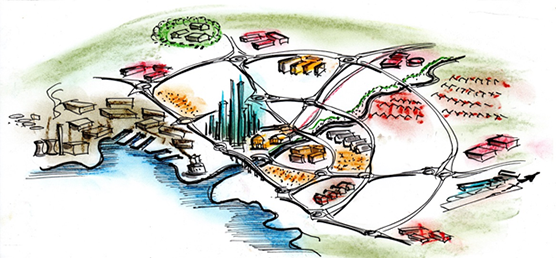
Dr. Ravetz’s impression of Helsinki metropolitan area. It is, in outline, built up of specialized housing areas, industrial hubs, business and retail parks. In the City of the Future we need to rethink everything we know about cities in order to have the systems of living, working and playing to interact without excessive car-based traffic.
The public lecture held by Dr Joe Ravetz is loaded with hand drawn maps and pictures. Even his self-presentation on the Urban 3.0 website is partly a comic strip.
– I am a researcher of sustainable futures for urban and regional development, but also an architect and a drawer, he points out.
– I believe pictures are the best way to communicate about complex systems such as cities.
Updated version of city
Dr Ravetz is giving his lecture as part of a week-long visit to SYKE in January 2015. He pictures the future of cities; how the different networks of economy, governance, transport, services, resources, social relations etc. start to connect in a ‘synergistic’ way.
Dr Ravetz calls the next-generation city as Urban 3.0.
– The 1.0 industrial city was a mechanical model with resource input in one end, smokestack production in-between, and waste and pollution coming out the other end, Dr Ravetz explains.
– The 2.0 post-industrial city is a more biological system; it is more smart and entrepreneurial with areas specialized to mono-functional nodes. Basic principle is that winners take all, while outsourcing their problems on a global scale.
The Urban 3.0 city looks beyond, to a model of creative synergy, self-organizing collaboration, and networked social intelligence. The Urban 3.0 city-region has multi-functional nodes based on green infrastructure and human mobility. Circular economies and circular material flows are working at both city-region and local levels. The synergistic systems of an Urban 3.0 city-region can more easily respond to local problems and also complex global problems such as climate change, social exclusion, and economic vulnerability.
From planners to gardeners
Tomorrow’s community architects, city planners, and environmental policy-makers need to be more like gardeners than designers, Dr Ravetz points out.
– All the inter-connected networks of an Urban 3.0 city-region cannot be built from scratch, they need to grow. The task of planners will be to spot the seeds of social intelligence sprouting around, and start nourishing them.
Dr Ravetz’s visited SYKE in connection with the launch of the Urban Zone 3 project.
– In the project we will analyse future pathways of urban form in Finnish city regions and apply the method of urban zones to planning of infill development, the project coordinator Mika Ristimäki from SYKE explains.
The project is a follow-up of earlier Urban Zone projects and it draws on the Model of Three Urban Fabrics, also developed at SYKE.
Dr Joe Ravetz is Co-Director of the Centre for Urban Resilience & Energy at the University of Manchester. He has worked on strategic thinking for sustainable cities and regions, with interests in environment policy, urban development, new economics and governance, innovation and futures studies, systems and complexity science. His book “Urban 3.0: Creative synergy and shared intelligence for the One Planet century” will be published in 2015 by Earthscan, Routledge.
Video recording of Dr Ravetz's lecture
Additional information
Senior Research Scientist Mika Ristimäki, SYKE
Phone: +358 295 251 567
E-mail: firstname.lastname@ymparisto.fi (firstname = mika, lastname = ristimaki)
Text: Matti Lindholm, SYKE
Picture: Joe Ravetz